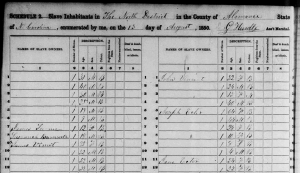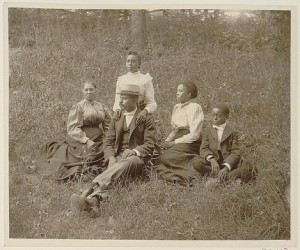Black History Month is a great time to get inspired to research your family’s unique contributions to American History. African American genealogical research has distinctive challenges but can also produce rewarding results. Getting started is often the most difficult step. While it is usually easy to trace an African American family in the years following the Civil War, it can prove difficult to trace a family before the war. Here some suggestions.
Begin by noting the surname of your ancestor in the 1870 census. Sometimes former slaves took their former owner’s name, which will help you locate earlier records. Then search for your ancestor’s known surname in earlier census records. If your ancestor was free prior to the end of slavery, he or she may appear in an earlier census by name. If your ancestor was a slave, check the 1850 and 1860 United States Slave Schedules for the surname in the location where your ancestor was living in 1870. The Slave Schedules typically record the slave owner’s name and a description (age, sex, and complexion) of each slave in the household. Look for a slave owner with the same surname as your ancestor, and then see if one of that person’s slaves fits your ancestor’s description.
Many former slaves already had surnames prior the end of slavery. Some, following emancipation, chose a surname that differed from their former owner’s surname; others had the surname of an earlier owner. If you cannot locate your ancestor’s known surname in the Slave Schedules, look at the names of other people in your ancestor’s known location; one or more neighbors may have been owned by the same person as your ancestor and thus have taken that earlier owner’s surname.
To identify a former slave owner, you may need to dig deep into records created shortly after emancipation, such as documents from the Freedmen’s Bureau and the Freedman’s Savings and Trust. (Only a small portion of the Freedmen’s Bureau’s records are available on microfilm, and many of the records are available only at the National Archives in Washington, D.C. NEHGS holds an inventory of the collections in our library.) Those records can also help you identify where your ancestor was living shortly after the Civil War; most freed slaves did not move far from where they had lived previously.
If you are having difficulty determining a specific location for your ancestor close to the Civil War, check the 1867 Voter Registration Records. As a part of the Reconstruction Act, all southern states were required to registered eligible citizens, black and white, to vote. Often, these records—held at the state level—are some of the earliest records to locate a male ancestor after the Civil War. The 1867 Voter Registration lists for Georgia and Texas are available at Ancestry.com; the Alabama Department of Archives and History has a searchable database of the state’s records.
Once you have identified a former slave owner, search for any records you can of him or her and his or her family. Probate, land, and account records are particularly useful since slaves were considered personal property prior to the end of slavery. Since slaves were sometimes sold or given to family members, it can be helpful to look for records of the slave owner’s relatives as well.
For more tips and suggestions for in-depth research on your African American ancestors, look for the new African American Genealogy Study Guide that will be added to the American Ancestors Learning Resources webpage in the coming weeks, and join me for a webinar on the topic on Thursday, March 26. See our Online Classes schedule for details.
Share this:
About Meaghan E.H. Siekman
Meaghan holds a Ph.D. in history from Arizona State University where her focus was public history and American Indian history. She earned her B.A. in history from Union College in Schenectady, New York, the city where she grew up. Prior to joining the NEHGS team, Meaghan worked as the Curator of the Fairbanks House in Dedham, Massachusetts, as an archivist at the Heard Museum Library in Phoenix, Arizona, and wrote a number of National Register Nominations and Cultural Landscape Inventories for the National Park Service. Meaghan is passionate about connecting people with the past in meaningful and lasting ways. She enjoys finding interesting anecdotes about an ancestor to help bring the past to life.View all posts by Meaghan E.H. Siekman →

